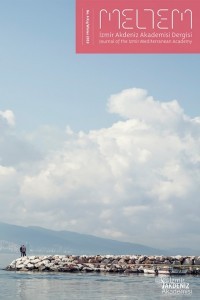Balcony As An Intermediate Space: A Prosthetic Threshold In The Domestic- Urban Life of Izmir
In the history of housing, balconies always appear as an important threshold between indoor and outdoor as well as between private and public life. In the transformative story of housing, we observe that, as new spaces have been introduced into design solutions, some spaces have undergone transformations or evolved like an organism, and some of them have gradually become subject to shrinking, or even extinction. In the current case of Izmir, the balconies generally fall into the last category, as prosthetic thresholds. Therefore, in this study, we tried to reveal the transformation story that extends to near extinction of balconies, by making comparison, and display that there is a legible difference between the late modern and post-modern cases of multi-storey housing-blocks in Izmir. The difference gives clues about possible transformations in inhabitants’ life-styles, besides referring to the condition of balconies in contemporary design solutions.
Anahtar Kelimeler:
Balcony, threshold space, prosthetic space, apartment-building, housing-unit plan.
Balcony As An Intermediate Space: A Prosthetic Threshold In The Domestic-Urban Life Of Izmir
In the history of housing, balconies always appear as an important threshold between indoor and outdoor as well as between private and public life. In the transformative story of housing, we observe that, as new spaces have been introduced into design solutions, some spaces have undergone transformations or evolved like an organism, and some of them have gradually become subject to shrinking, or even extinction. In the current case of Izmir, the balconies generally fall into the last category, as prosthetic thresholds. Therefore, in this study, we tried to reveal the transformation story that extends to near extinction of balconies, by making comparison, and display that there is a legible difference between the late modern and post-modern cases of multi-storey housing-blocks in Izmir. The difference gives clues about possible transformations in inhabitants’ life-styles, besides referring to the condition of balconies in contemporary design solutions.
Keywords:
Balcony, threshold space, prosthetic space, apartment-building, housing-unit plan,
___
- Altman, Irwin. The environment and social behavior: privacy, personal space, territory, crowding. Monterey: Brooks/Cole, 1975.
- Aronis, Carolin. “The Balconies of Tel-Aviv: Cultural History and Urban Politics.” Israel Studies 14, no. 3 (Fall 2009): 157-80.
- Batur, Enis. Kediler Krallara Bakabilir. Istanbul: Sel Yayıncılık, 2002.
- Bilgin, İhsan. Konut Üretiminin Karşılaştırmalı Analizi. Istanbul: YTÜ Yayınları, 1992.
- Bilgin, İhsan. “Housing and Settlement in Anatolia in the Process of Modernization.” In Housing and Settlement in Anatolia A Historical Perspective, edited by Yıldız Sey, 472-90. Istanbul: Tarih Vakfı Yayınları, 1996.
- Çıkış, Şeniz, and Fatma İpek Ek. “Konutta Lüks Kavramının İmgesel Dönüşümü: İzmir Kent Merkezinde Çok Katlı Lüks Konutlar.” Mimarlık Dergisi 348 (July-Agustos 2009): 64-71.
- Eco, Umberto. On Beauty: A History of a Western Idea. Translated by Alastair McEwen. London: Secker & Warburg, 2004.
- Eyüce, Ahmet. “Ege’de Konut.” Ege Mimarlık, no.13 (1994): 17-30.
- Gehl, Jan. Life Between Buildings: Using Public Space. New York City: Van Nostrand Reinhold, 1987.
- Giucastro, Fabio G.S., and Dario Giordano. “Et(h)nic Architecture in Mediterranean Area.” Energy Procedia 96 (2016): 868-80.
- Goldman, Anat. “The Process of Transition and its Expression in the Building Façades: The Case of Tel Aviv from the 1920s to the Present Day.” In The City and the Process of Transition from Early Modern Times to the Present, edited by Magdalena Gibiec, Dorota Wiśniewska, and Leszek Ziątkowski, 145-73. Newcastle upon Tyne: Cambridge Scholars Publishing, 2019.
- Güner, Deniz, ed. İzmir Mimarlık Rehberi 2005. Istanbul: Mas Matbaası, 2005.
- Hajer, Maarten, and Arnold Reijndorp. In Search of New Public Domain: Analysis and Strategy. Rotterdam: NAi Publishers, 2001.
- Hakim, Besim S. Mediterranean Urbanism: Historic Urban / Building Rules and Processes. New York City: Springer, 2014.
- Hillier, Bill, and Julienne Hanson. The Social Logic of Space. Cambridge: Cambridge University Press, 1984.
- Kant, Immanuel. Observations on the Feeling of the Beautiful and Sublime. Translated by John T. Goldthwait. Berkeley: University of California Press, 1960.
- Kuban, Doğan. Türk “Hayat”lı Evi. Istanbul: Mısırlı Matbaacılık A.Ş., 1995.
- Lefebvre, Henri. Rhythmanalysis: Space, Time and Everyday Life. London: Continuum, 2004.
- Rapoport, Amos. The Meaning of the Built Environment: A Nonverbal Communication Approach. Beverly Hills: SAGE Publications, 1982.
- Savranoğlu Yapı. “Venüs Apartmanı.” Accessed May 28, 2020. http://www.savranogluyapi.com/ tamamlanan-projeler/venus-apartmani.
- Sey, Yıldız. “To House the New Citizens: Housing Policies and Mass Housing.” In Modern Turkish Architecture, edited by Renata Holod and Ahmet Evin, 159-83. Philadelphia: University of Pennsylvania Press, 1984.
- Skjaeveland, Oddvar, and Tommy Garling. “Effects of Interactional Space on Neighbouring.” Journal of Environmental Psychology 17, no. 3 (1997): 181-98.
- Stevens, Quentin. “Betwixt and between: Building thresholds, liminality and public space.” In Loose Space: Possibility and Diversity in Urban Life, edited by Karen A. Franck and Quentin Stevens, 73-92. London and New York: Routledge, 2007.
- Tekeli, İlhan. “Türkiye Kentlerinde Apartmanlaşma Sürecinde İki Aşama.” Çevre, no. 4 (July-Agustos1979): 79.
- Tekeli, İlhan. “Bir Modernleşme Projesi Olarak Türkiye’de Kent Planlaması.” In Türkiye’de Modernleşme ve Ulusal Kimlik, edited by Sibel Bozdoğan and Reşat Kasaba, 136-52. Istanbul: Tarih Vakfı Yayınları, 1998.
- Tekeli, İlhan. “Akdeniz, Akdenizlilik ve Mobilite.” Meltem Janurnal of the Izmir Mediterranean Acedemy, no. 3 (Summer 2018): 7-29.
- Terim, Belgin. “İzmir’de Çok Katlı Konutlara Dünden Bugüne Bir Bakış.” Ege Mimarlık, no. 57 (2006): 36-41.
- Varela Alvaro, Susana M., and F. Javier Neila González. “The architectural culture of the Eurasian Mediterranean region: a testimony of satisfactory design for urban infrastructures.” GSTF Journal of Engineering Technology 3, no. 1 (2014): 17-22.
- Watsuji, Tetsuro. A Climate: A Philosophical Study. Translated by Geoffrey Bownas. Tokyo: Printing Bureau, Japanese Government, 1961.
- ISSN: 2602-2508
- Başlangıç: 2017
- Yayıncı: İzmir Büyükşehir Belediyesi
